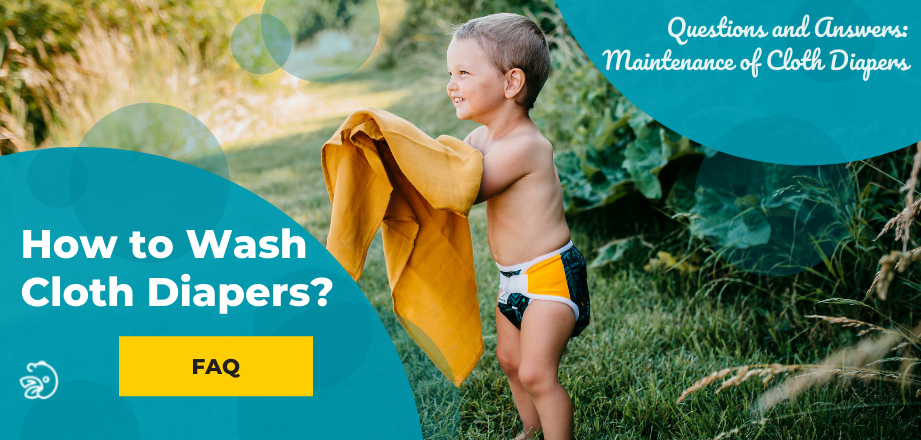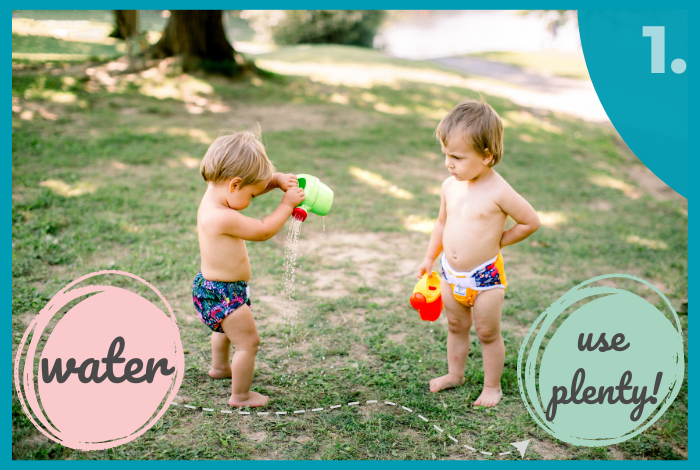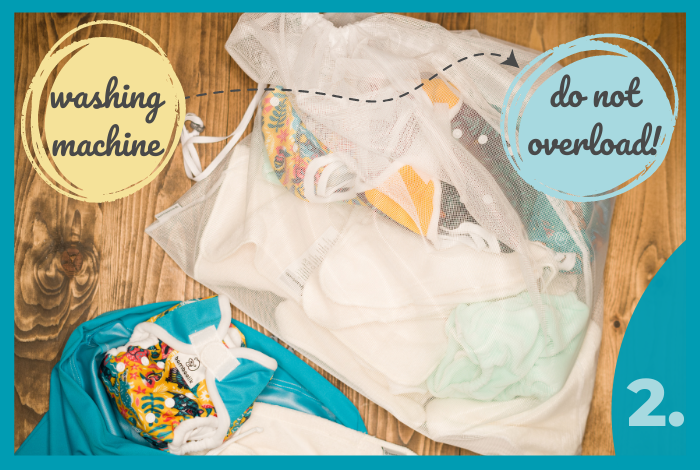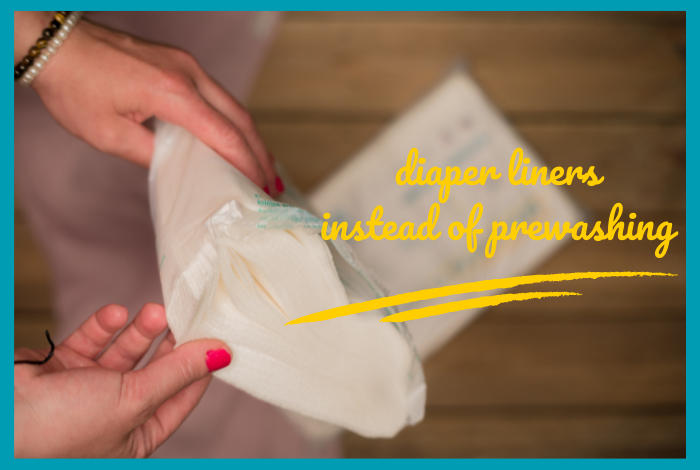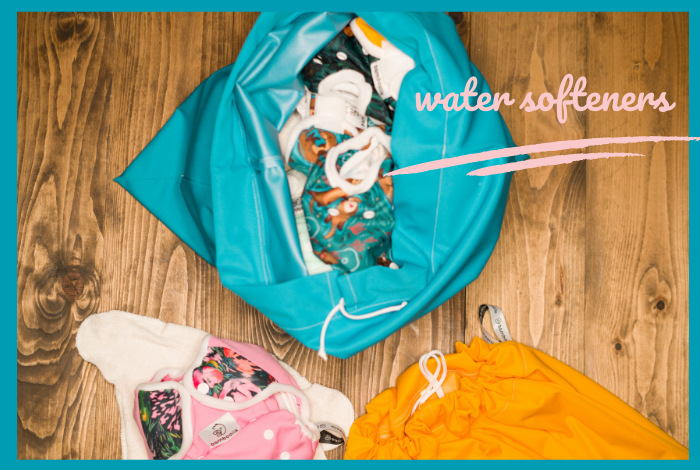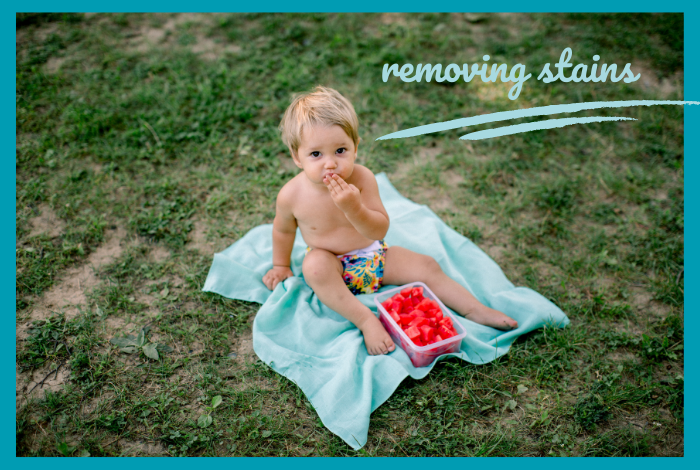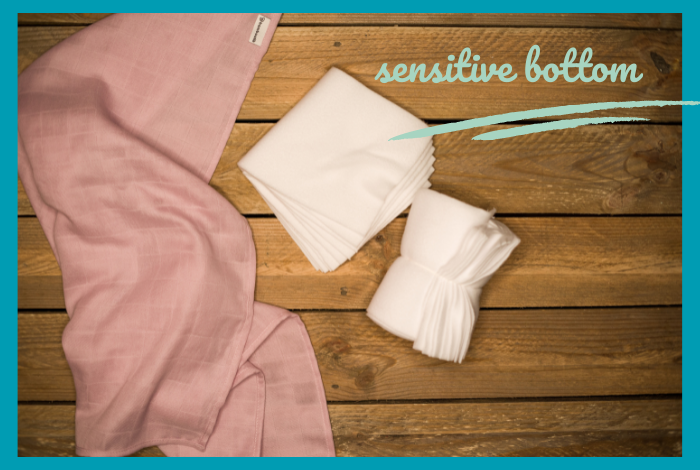How to Wash Cloth Diapers
We are often asked whether there is some special procedure to follow when washing cloth diapers, whether we recommend a specific detergent, what to avoid during the maintenance of diapers and so on. So what are our findings and recommendations?
- Diapers are washed properly only in a sufficient amount of water.
- Do not overload your washing machine.
- Wash diapers at 60o.
- Do I need to prewash diapers by hand?
- How to wash diaper covers soiled from stool?
- What detergent to use?
- We have very hard water at home. What shall we do?
- There are stains left on the diapers after washing. How can we get rid of them?
- How to disinfect the diapers?
- My baby has a rash under the diaper. Everybody tells me it is caused by the cloth diapers. What do you recommend?
3 KEY DIAPER PRINCIPLES or THE HOLY DIAPER TRINITY
1. Diapers are washed properly only in a sufficient amount of water..
This point is absolutely crucial for the entire washing process. During their use, diapers soak up fluid (and let's say it straight, this fluid is nothing but urine), which then needs to be properly rinsed. You will not reach this otherwise than by using a sufficient amount of water. Hence, beware of various eco programs in your washing machines, these usually mean less water.
- If possible, use a prewash program and add extra rinsing at the end (to make sure that all detergent is rinsed out of the diaper). Use a long washing program (we recommend at least two hours), diapers need a proper and long wash cycle.
- If your washing machine does not have the options of prewash or extra rinsing, just use a short washing program (without any detergent) instead, it will do the same job.
- In case your washing machine is so "eco-friendly" that it automatically uses little water and does not have the "add water" button, simply add water into the drum (some people use the water collected from the tumble dryer to recycle it; another benefit is that this water is distilled and the washing powder dissolves better in it).
How do you know there is enough water in the drum during the wash? Simply: you should see the water (if you can see only the diapers and a little foam rolling in the drum, then the water is low). If you cannot see into your washing machine, you will recognize the lack of water especially if the diapers smell slightly musty after washing; they will lack the typical smell of freshly washed laundry.
2. Do not overload your washing machine.
This point is closely related to point 1. Too many diapers mean that the water needed for washing is low.
- Follow the maximum weight limits according to the instructions for your washing machine. Make sure you check whether the weighing data in the manual is given for dry or wet laundry (which makes quite a difference in our super-absorbent diapers).
- We have found that for washing machines with a 5 kg capacity, it is usually necessary to wash after a maximum of 2 days (if you use only cloth diapers), otherwise the washing machine is too full.
3. Wash diapers at 60o.
Please forget about diapers where 30o or 40o wash is recommended. In order for the diapers to be really hygienically clean, a temperature of 60o is required.
At lower temperatures, there is no guarantee that you will dispose of all bacteria that may be present in the diapers. Bacteria can then cause a variety of troubles - babies' health problems to start with (diaper dermatitis, inflammations), and destruction of diapers not to forget (especially bamboo diapers are very tasty to bacteria, we have it tested :-)).
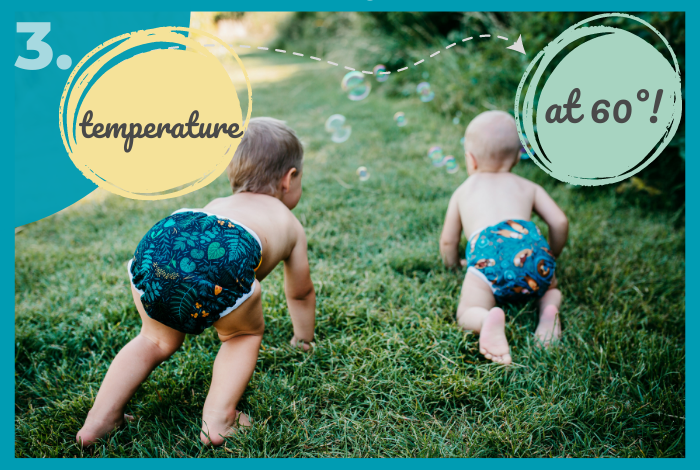
AND WHAT ELSE DO YOU OFTEN ASK US ABOUT?
Do I need to prewash diapers by hand?
You definitely don’t have to! All you need to do is remove the solid parts of dirt (in technical terms: shake the poop off :-)) and then place the diaper to a diaper pail or straight into the washing machine. Pre-wash in hand is not necessary, on the contrary, we do not recommend it, especially with the Diaper Cover - you could damage its lamination by rubbing in hand.
And by the way, shaking the poop off will be easier if you use Disposable Diaper Liners. Just throw them away together with its contents ;-)
How to wash diaper covers soiled from stool?
The big advantage of the AI2 and AI2 Duo system diaper covers is that they DO NOT NEED to be washed after each use. Please bear in mind, however, that in case of newborn babies, until the stool becomes firm and less frequent, it is quite normal that you add the covers to your diaper laundry after each use. Dont worry, the covers are made to withstand this.
When maintaining diaper covers, pocket diapers, training pants - basically all parts containing the laminated PUL layer, always bear in mind:
- The diaper covers must not be scrubbed manually - hand washing is much rougher for them than washing at 60 degrees in a washing machine! We often receive complaints with damaged diaper covers. Unfortunately, we cannot accept complaints in case of inappropriate maintenance.
- Remove stool residues from the cover with a stream of water, do not rub it manually. If necessary, drip the stain with liquid gall soap and leave it for a while. Then throw into your diaper pail or wash together with all the used diapers - at a long 60-degree program, as normally.
- It is good to wash the diaper covers once every 7-10 days, or whenever they are soiled. Keep in mind: A month without washing can damage the diaper cover much more than washing it every week.
- You often ask us, "How do I put a diaper on a baby so that the stools do not soil the diaper covers so we don't have to wash them?" - Unfortunately, this cannot be avoided every time. Especially in the first months of your newborn baby when the stool is liquid and frequent, this is pretty normal, you are not doing anything wrong. Just wash the covers whenever they are soiled. Most of the "dirty load" can be caught by a diaper liner, but if a little stool gets on the edges of the diaper covers, you simply have to wash them. This is why our diaper sets contain such number of diaper covers to make sure you have enough of them even if one or two pieces are just in the laundry. It is normal that with a small baby, you will wash the soiled covers more often than later on with older children who usually make poo once a day. Don't worry, the covers are durable enough to handle this more frequent washing in the first months!
- Attention: On the other hand, tumble-dryer is not suitable for diaper covers! The dry hot air can, in contrast to hot water in the washing machine, definitely harm them. (The same applies to pocket diapers, training pants and accessories containing the waterproof PUL layer.)
- Just after taking out of the washing machine, do not try to stretch the diaper covers and pockets of the pocket diapers, as this could gradually loosen the elastic rubber bands around the legs, and the covers and pockets would not fit tight anymore. Simply hang the wet covers and pockets on the cord. If drying outside, you can use the velcros of the pants for attaching them to the cord (so that they don't fly away :) ).
What detergent to use?
You can use any detergent which you like and does not cause you or your baby any unwanted reactions. In Bamboolik, we prefer ecological detergents that do not burden the environment. The choice of a specific powder / gel / slime is only up to you. Just be careful with soap and soap-based detergents - they should not be used with fleece material as they tend to clog it (in simple terms, soap can impregnate the fleece surface, which is not very desirable in diapers). However, if you still want to use soap-based detergents, make sure you use plenty of water in the washing program and add extra rinsing at the end.
Observe the dosage of the selected detergent. More powder does not really mean better washed diapers. On the contrary, if you use too much powder, it will be harder to rinse out and may stay in your diapers and clog them (and then irritate your baby's skin). Particularly in combination with lack of water (see point 1), this could be a very significant problem.
And what about home-made soap slime? Honestly, we cannot recommend it in general even though we know that for some people, it works perfectly for diapers. Actually, we also know that for others, it does not work at all. Why? Among other parts, soap slime consists of soda which reacts with ions in water, specifically by neutralizing calcium ions (which cause water hardness). Soda, however, does not neutralize magnesium ions that mght also be present in the water. Soda and magnesium ions can react unpredictably: acidic solutions may occur which can damage (sometimes even dye) the laundry or washing machine. You probably do not know the exact composition of your water, so we can not predict if your soap slime will or will not work.

We have very hard water at home. What shall we do?
As mentioned above, adding a bit of soda into the drum might help, or there are water softeners which will also help to neutralize other ions in addition to calcium ions. Definitely do not use any fabric softeners to soften the water or laundry, as it reduces the absorbency of the diapers (the fabric softeners coat textile fibers, which is very undesirable with the diapers, since the moisture they need to absorb would not be able to get through to them).
Home-made "softeners" such as diluted vinegar or citric acid also work well. They are very easy to make even for those who are not so much into DIY: Mix 100 ml of vinegar or 100 g of citric acid with 900 ml of water. This creates a 10% solution that you will use as a classic softener. Attention! We really do not recommend to pour pure vinegar or citric acid into your washing machine (regardless the fact that there is „8%“ written on the vinegar, that is the normal vinegar concentration). Always make the 10% solution first.
There are stains left on the diapers after washing. How can we get rid of them?
First and foremost, remember that coloring on diapers does not mean they are not cleanly washed. Especially with the introduction of the first baby food, it may happen that some of the delicacies will dye the diapers (for example, banana is a champion in this area). However, the dye on the fiber does not mean a dirty diaper, and we can assure you that the color will disappear with time.
If the stains do bother you, try sodium percarbonate - combined with a 60o temperature, it bleaches perfectly. It works like peroxide, just as sunshine does - in the summer and spring, line dry the diapers outside and the stains will disappear instantly (it's a much better way than chemical bleach, believe us!).
How to disinfect the diapers?
First of all, it is important to say that if the diapers are properly stored and washed, it is not necessary to disinfect them just as a precaution. Disinfection comes into question only in really serious cases, for example, if your baby is fighting a really serious intestinal infection (rotaviruses and similar bugs). In such case, use a disinfectant and a high temperature (90 degrees, the diapers will survive it as a one-off – including diaper covers and AIO pockets). However, this should really be an exceptional measure, definitely don‘t do this to your diapers regularly. If you use chemical disinfection, wash the diapers once more in the washing machine without a detergent, in order to rinse the disinfectant out properly.
In Bamboolik, we have had the best results for disinfection and bleaching of diapers with sodium percarbonate, as mentioned above. If you need a proper disinfection, put the diapers in a bucket, add 3-5 spoons of percarbonate (depending on the number of diapers) and pour in hot water (at least 60o) in the amount to fill up the bucket only half-way. The percarbonate will start to foam heavily; it is highly recommended to place the bucket into the bathtub first! Otherwise this „cocktail“ might run out of the bucket, as seen in the picture ☺. Leave the diapers bubble for about 2-3 hours, stir occassionally. After that, move the whole bucket content into the washing machine and wash at your regular washing program for diapers. Remember to rinse well at the end!
The same procedure can be used for removing stains or sediments, or if you feel the diapers smell musty, or in case your baby has got a rash after wearing the diapers. This bath will make the diapers feel like brand new. In case of sediments, you can also use citric acid instead of the percarbonate, following exactly the same steps. Use one packet of citric acid, i.e. 100 g.
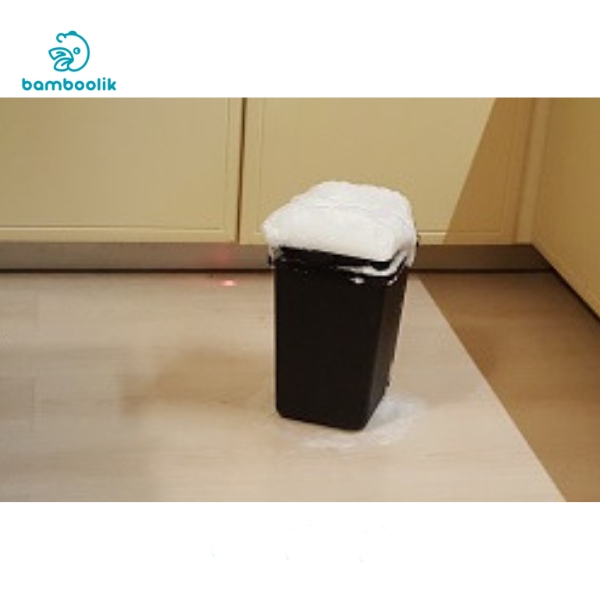
My baby has a rash under the diaper. Everybody tells me it is caused by the cloth diapers. What do you recommend?
Based on our multiple-children-experience, we can say that the baby’s skin does not get irritated by the cloth diapers as such, but by some elements which are not supposed to be there. Usually, these are residues of washing powder (caused by insufficient final rinsing), or residues of urine or stool (washing in insufficient amount of water, washing at temperature lower than 60o). In such cases, we can heartily recommend you to run the diapers through a percarbonate or citric-acid bath as described in the previous point. In case the trouble still persists, it is likely that your baby’s urine or stool became more aggressive and irritates him or her (sometimes this happens e.g. during teething). In such case, a Fleece Liner could help, as it makes a barrier between the moist and the skin.
In case of any further questions, do not hesitate to contact us, we will be happy to help!

